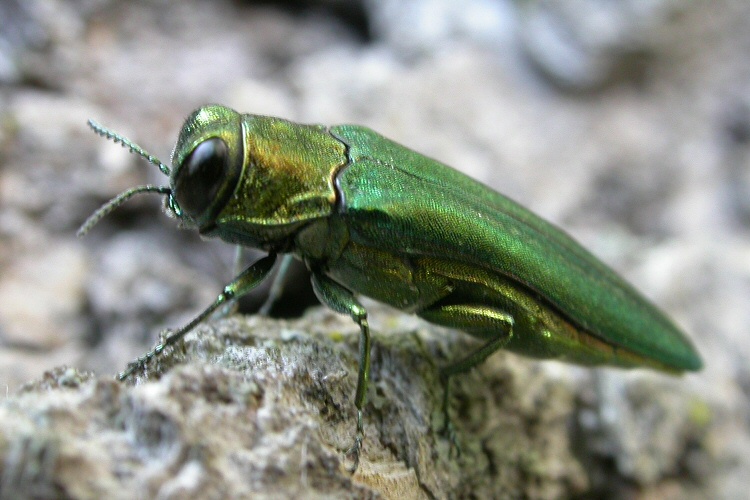
Read more about how the emerald ash borer is affecting the metro from Greenability, featured in our July/August issue. Access your digital subscription to read the story.
As part of the monitoring process for the spread of Emerald Ash Borer (EAB) in Johnson County, Dennis Patton, horticulture agent with Johnson County K-State Research and Extension, confirmed Wednesday, August 27, the presence of Emerald Ash Borer in Ash trees in Shawnee Mission Park.
Working with staff from the Johnson County Park & Recreation District (JCPRD), Patton supervised the inspection of limbs from several suspect trees. After cutting through the bark, Patton discovered the telltale winding S-shaped tunneling that damages a tree’s cambium. Patton also confirmed the presence of EAB larvae.
EAB was first found in northern Johnson County in 2013. The Kansas Department of Agriculture confirmed the insects’ spread into Roeland Park and Shawnee in June this year. “With these new confirmations it is clear that the EAB population is spreading in Johnson County,” said Patton. “We recommend Ash tree owners that wish to save trees in excellent-to-good condition start treating their trees next spring.”
Patton went on to add, “Tree owners need to understand that this is not a one-and-done deal. If you decide to treat your trees, it’s with the understanding that it is for the life of the tree.”
Emerald ash borer, Agrilus planipennis, a wood boring insect, was first detected in Michigan in 2002. The insect has killed millions of ash trees in its path, and is now present in twenty three states. Kansas City, Missouri Parks and Recreation estimates that there are 4.6 million ash trees in the region at risk.
The discovery of the infested trees within Shawnee Mission Park was on the south side of the park within the city limits of Lenexa.
“JCPRD completed an EAB management plan in late 2013,” said Bill Maasen, Superintendent of Parks & Golf Courses for JCPRD. “Within the plan, it was determined that only trees in a landscaped environment will be managed and treated because there are quite simply too many naturally occurring ash trees in the native forested areas of our parks.”
To date we have treated over 200 trees in a preventative manner,” Maasen added.
Patton’s advises tree owners not to panic. “But now is the time to assess your situation and determine the best course of action for you and your pocketbook, which can range from treatment to letting nature run its course.”
Before any action is taken, homeowners should assess the health and value of their tree. Preventive treatment options are available, but should only be considered for trees that are healthy and a value to the landscape. If left untreated, it is estimated that EAB will kill 98% of the region’s Ash trees in the next 10 years.
The Extension office has detailed information with points tree owners should consider when dealing with emerald ash borer. The information is available at www.johnson.ksu.edu or by calling (913) 715-7000.
Greenability magazine featured “Metro area braces for emerald ash borer” in our July/ August 2014 issue including tips on how to identify the beetle, signs of infestation and local resources to help your trees. Also, discover how a local company, Missouri Organic is safely repurposing infected trees. Read more here.
Dennis Patton, horticulture agent with the extenstion service will speak Sept. 15 about the spread of the borer and treatment options at Lenexa Community Center. Register in advance at https://econnect.lenexa.com/start/start.asp.




